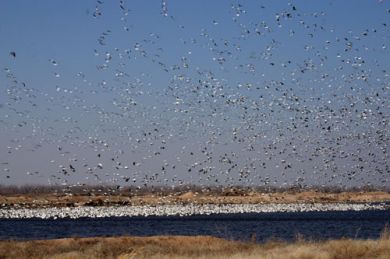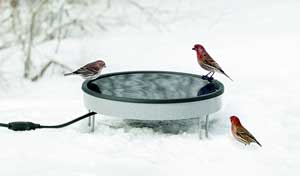Blog - General
Dave’s November Bird Chatter

This is the major month for the ducks and geese to move off their northern breeding grounds as they head for open waters to the south. If you are fortunate enough to see thousands of geese taking off in unison from a lake or wetland, you will not soon forget the thrill. In the Midwest and Central Great Plains there are a large number of locations where this event can raise goose-bumps on your skin. More and more people are driving to these areas each year to view this natural phenomenon of migration, and the effort is well worth it.
After a year of spring floods and heavy rains, the nests of many early ground nesting birds such as turkey, pheasants and quail, may have been washed out. We don’t know how many or how wide spread this was. I am certain it impacted many other grassland birds in flooded waterways. With a cool and very wet spring and warm summer there should be an ample food supply for birds in most trees, fruit bearing shrubs, grasses and forbes. This ample food source could also hold a large number of birds over later in the season. But many times, heavy ice and snow can quickly cover up this ready supply. I feel that a possibility of more birds in the area might mean an overall more exciting season than we might expect. As for the nut producing trees, last year produced a noticeable shortage especially walnuts. This led to more raccoons and squirrels robbing bird feeders. It also impacted deer, chipmunks, jays, and wood ducks. Again this year squirrels and raccoons are making their presence know at the backyard bird feeders.
Now is a good time to clean up your bird bath heater before the temperatures plummet. Use a strong solution of vinegar to remove the  scale and it will perform at its peak. Most heaters collect a film of calcium on it from the water during last years use. It will perform better if these minerals are removed as the heater will have a better contact with the water. If you’re still not sure if it is functioning properly, place the heater in the freezer for about 20 minutes. Remove it from the freezer and plug it in. It should turn on. These products either work or not. Also, avoid extension cords over 25 feet as this will affect the performance of the heater. And be sure that the outlet it is plugged into is working properly. If you do need a new heater, or it’s a first time purchase of one, check with Wild Bird Habitat for a complete line of bird bath heaters and de-icers.
scale and it will perform at its peak. Most heaters collect a film of calcium on it from the water during last years use. It will perform better if these minerals are removed as the heater will have a better contact with the water. If you’re still not sure if it is functioning properly, place the heater in the freezer for about 20 minutes. Remove it from the freezer and plug it in. It should turn on. These products either work or not. Also, avoid extension cords over 25 feet as this will affect the performance of the heater. And be sure that the outlet it is plugged into is working properly. If you do need a new heater, or it’s a first time purchase of one, check with Wild Bird Habitat for a complete line of bird bath heaters and de-icers.
This is perhaps one of the most exciting times for anticipating new birds. What will tomorrow bring? Stay alert for any new bird at your feeders. Each new day can be a bonanza for any time. Watch carefully for migration stragglers that are headed south, staying just a matter of days ahead of the approaching winter. Robins, Brown Thrashers, Towhees, Catbirds and others. In early November it’s not uncommon to see Vireos and warblers heading south. Many of these birds will stop at a water source in your backyard and glean the ground and remaining leaves for insects. Others may take foods they generally ignore during the summer. This is also the month many northern birds who will be spending the winter with us will start to show-up at our bird feeders. Already we are receiving reports of Red-breasted Nuthatch, Dark-eyed Juncos, and Harris’s Sparrows and Red-crossbills arriving. Many others are on they’re way as well. Pine Siskin, Purple Finch, White-winged Crossbills. Its anyone’s guess as to who might appear this winter. Evening Grosbeaks? With a variety of bird feeders, a good assortment of wild bird feeds, and a source of water, you’ll be certain to not only attract our winter resident birds, but those visiting us from the north as well.
